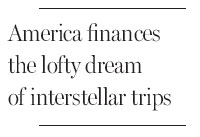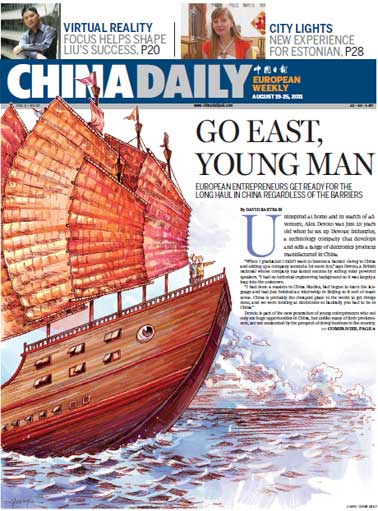Top News
Next stop, Alpha Centauri
Updated: 2011-08-28 07:59
By Dennis Overbye (The New York Times)
|
Some scientists believe human travel to another star is possible but it may take centuries to develop the needed energy resources. Adrian Mann |
The United states government agency that helped invent the Internet now wants to do the same for travel to the stars.
Darpa, the Defense Advanced Research Projects Agency, plans to award some organization roughly $500,000 in seed money to begin studying what it would take - organizationally, technically, sociologically and ethically - to send humans to another star, a challenge of such magnitude that the study alone could take a hundred years.
The awarding of that grant, on November 11 - 11/11/11 - is planned as the culmination of a yearlong Darpa-NASA effort called the 100-Year Starship Study, which will include a three-day public symposium in Orlando, Florida, starting on September 30 on the whys and hows of interstellar travel. The Darpa plan has generated buzz as well as befuddlement in the labs, pubs, diners and Web sites that ring NASA centers both physically and virtually, where the dream of space travel has never died.
"If you want to have a hobby, why can't it be designing an interstellar spacecraft?" said Andreas Tziolas, who teaches at the University of Alaska and directs Project Icarus, a worldwide volunteer effort to design a spacecraft that could carry a scientific probe to a nearby star - perhaps Alpha Centauri, 4.4 light-years from here - in a trip that would take less than 100 years.
People like Dr. Tziolas say the technology already exists or will soon exist to send instruments and perhaps people to nearby stars, although a human flight could cost hundreds of trillions of dollars. The half-million dollars Darpa will award is not enough to build a starship or even to buy a modest office in which to imagine one - but it is enough to start serious fund-raising and, perhaps, to invite ridicule from critics of government spending.
An actual human launching is at least a couple of centuries away and, barring the invention of Star Trek-like warp drives, could take additional centuries to complete. Whoever goes on such a journey will not be coming back.
 |
David Neyland, Darpa's director of tactical technology, points out that the goal of his project is not an interstellar spacecraft, only a business plan for designing one. The search, he said, is for an organization that can develop the interstellar vision without government help, carrying the load for 100 years, developing technological offshoots the way investing in computer protocols enabled the Internet. After this November, whoever it is will be on their own. "We don't intend to carry it forward," Mr. Neyland added. "Darpa hands the keys over to this entity, and we wish them well."
Interstellar travel is a difficult prospect. It would take Voyager 1, humanity's fastest artifact, now traveling 61,000 kilometers an hour relative to the Sun, more than 70,000 years to reach Alpha Centauri.
In its interstellar spaceship study in the 1970s, called Project Daedalus, the British Interplanetary Society suggested powering an interstellar spacecraft with tiny thermonuclear explosions caused by compressing pellets of deuterium and helium-3 with laser blasts. It would carry a 455-metric ton scientific probe to Barnard's Star, 5.9 light-years away, in about 50 years, reaching a top speed of 12 percent of the speed of light along the way.
Dr. Tziolas said, "That was the very first study that proved it's possible with knowledge we have now to travel to another star."
Other propulsion schemes include gigantic sails pushed by sunlight and ion drives in which beams of high energy particles do the propelling.
In recent years, the Tau Zero Foundation, based in Cleveland, was founded by Marc G. Millis, who directed propulsion research at NASA's Glenn Research Center, to encourage work on "practical interstellar flight." Last year Mr. Millis calculated that it would be at least 200 years before society had the energy resources to send 500 people out of the solar system.
 |
In January, Mr. Neyland and Pete Worden, director of NASA's Ames Research Laboratory in Mountain View, California, invited about 30 scientists, entrepreneurs and science fiction writers to a two-day brainstorming session. Mr. Neyland described the first meeting as an attempt to get past "the giggle factor" associated with the subject. Participants included scientists like J. Craig Venter of the J. Craig Venter Institute, who was one of the first to sequence the human genome, and the science fiction writer Joe Haldeman.
One participant said, "There were a few people on the other side of reality."
A call for ideas for the Orlando meeting drew hundreds of responses. Jill Tarter, an astronomer at the Search for Extraterrestrial Intelligence Institute in Mountain View, will coordinate talks on where to go. She has received 50 or 60 proposals, some of which read like U.F.O. reports.
"Maybe," she said, "you have to be a little bit crazy to think about this seriously."
Kelvin Long, a physics graduate student at Warwick University in Coventry, England, and a member of Project Icarus, said he had already thought about the floor plans, an organization chart and even a Japanese garden in the backyard for a pyramidal Interstellar Institute, where the research for an interstellar trip could be centered.
"A lot of us are quite young. We grew up hearing about the Apollo program," he said. "We want to be part of a significant journey. We personally think we may be doing something important, driving humanity out to the stars."
The New York Times
E-paper

City's dynamic teutons
German cluster gives a fillip, competitive edge to local economy in Taicang
Short and sweet
Game for growth
Character reference
Specials

Hunting grounds
Opinion divided as China debates opening door to international players

Flying the TCM flag
A small German town is home to Europe's flagship clinic for traditional Chinese medicine

Animal attraction
World's youngest chief fur designer set to launch own label and tap into huge China market.

